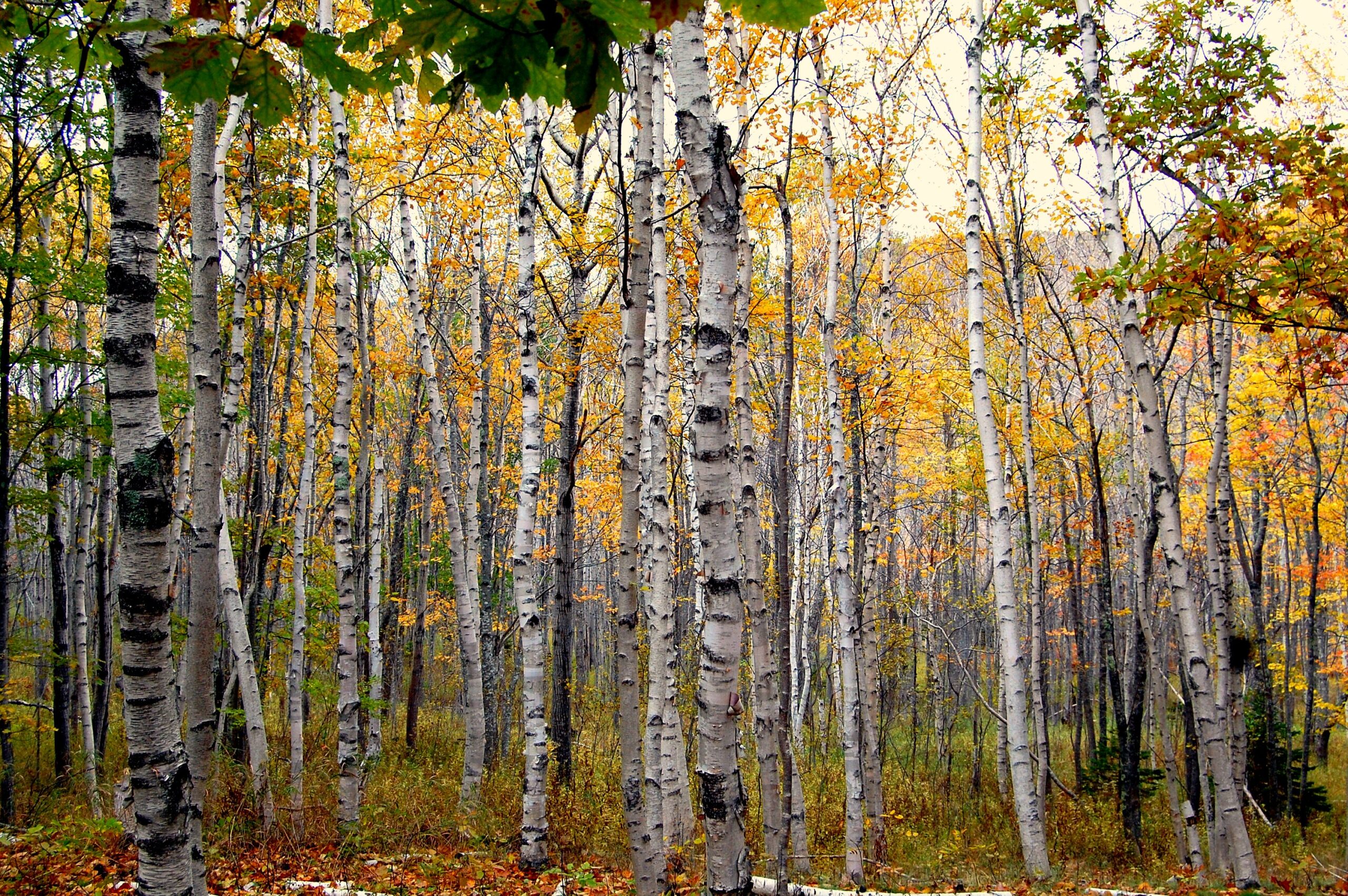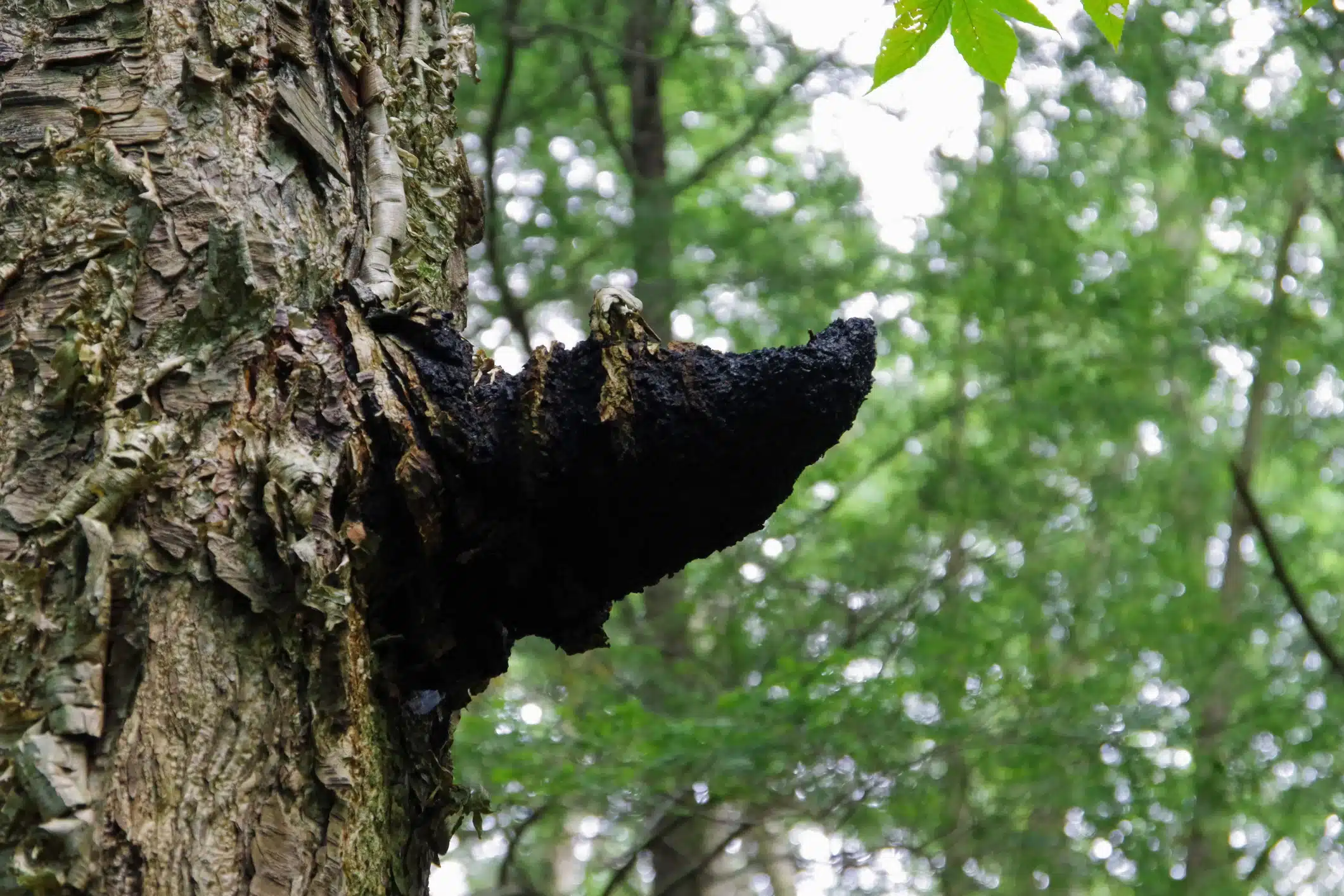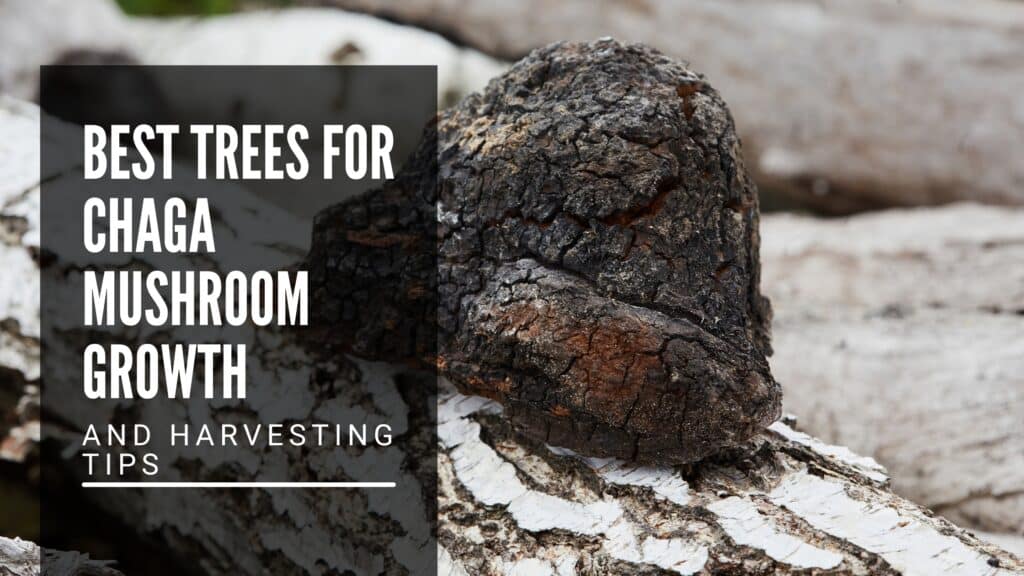Introduction
Chaga mushroom has gained significant attention for its potential health benefits, including boosting the immune system and combating inflammation. To locate this beneficial fungus, it’s crucial to know the specific trees it thrives on.
Quick Summary
- Primary Host: Birch trees, particularly in cold climates.
- Types of Birch: White Birch, Yellow Birch, Silver Birch.
- Other Potential Hosts: Alder, Beech, and Oak trees (less common).
- Growth Factors: Climate, geography, tree health, and age.
- Sustainable Harvesting: Importance of responsible foraging and legal considerations.
- Health Benefits: Higher concentrations of beneficial compounds from birch tree chaga.
Birch Trees: The Primary Host

Why Birch Trees?
Chaga has a unique affinity for birch trees, especially those found in colder climates. This relationship is more than just random growth; it’s a symbiotic partnership. Birch trees provide the ideal environment for chaga, offering the nutrients and conditions it needs to thrive. The bark and inner structure of birch trees contain compounds like betulin, which chaga converts into beneficial substances that contribute to its potent health properties.
Types of Birch Trees
There are several types of birch trees that serve as hosts for chaga. Each type has unique characteristics and grows in different regions, making chaga a versatile fungus with a broad geographical range.
White Birch (Betula papyrifera)
Also known as paper birch, white birch is a common sight in North America, especially in Canada and the northern United States. These trees are easily recognizable by their distinctive white bark that peels in paper-like layers. White birch is a primary host for chaga due to its widespread availability and favorable growing conditions.
Yellow Birch (Betula alleghaniensis)
Found in the northeastern United States and southeastern Canada, yellow birch has a bark that ranges from silver to yellowish-bronze. This birch species thrives in cooler, moist environments, making it another suitable host for chaga. The chaga that grows on yellow birch is noted for its robust health benefits, similar to those found on white birch.
Silver Birch (Betula pendula)
Predominantly found in Europe and parts of Asia, silver birch is known for its slender, graceful appearance and silvery-white bark. In regions like Scandinavia and Russia, silver birch forests provide an abundant source of chaga. The fungus that grows on these trees is prized for its high quality and medicinal properties.
The Symbiotic Relationship
The relationship between chaga and birch trees is fascinating. Birch trees offer a stable environment and a steady supply of nutrients. In return, chaga helps protect the tree from certain diseases and environmental stresses. This mutualistic interaction ensures that both the fungus and the tree benefit, creating a thriving ecosystem.
Importance of Birch Trees for Chaga’s Medicinal Properties
Birch trees are not just a host; they are essential for the unique medicinal properties of chaga. The bark of birch trees contains betulin, a compound that chaga metabolizes into betulinic acid. This acid is believed to contribute significantly to chaga’s anti-inflammatory and immune-boosting effects. Without birch trees, chaga would not have the same potent health benefits, underscoring the critical role these trees play in the lifecycle and efficacy of this remarkable fungus.
By understanding the deep connection between chaga and birch trees, foragers can better locate and harvest high-quality chaga, ensuring they capture the full range of health benefits this unique fungus offers.
Other Trees Chaga May Grow On
While birch trees are the primary host for chaga, this remarkable fungus can occasionally be found on other types of trees. These instances are less common and often result in chaga with different properties compared to those found on birch. Here, we explore the other trees that chaga might grow on and what makes these occurrences unique.
Alder Trees
Alder trees, particularly those in regions where birch trees are scarce, can sometimes host chaga. Alders are often found in damp environments like riverbanks and wetlands. Chaga growing on alder trees is not as potent as that on birch, but it still retains some beneficial properties.
Adaptability of Chaga: Chaga’s ability to adapt to alder trees showcases its resilience and versatility. In areas where birch trees are limited, chaga makes the most of available resources, although the nutritional content and medicinal benefits may differ.
Beech Trees
In certain European forests, beech trees have been reported to host chaga. Beech trees are characterized by their smooth, gray bark and can be found in temperate regions. These trees are less common hosts for chaga, and the fungus found on beech trees is still under research to fully understand its properties.
Regional Variations: The occurrence of chaga on beech trees is particularly interesting in Europe, where beech forests are more prevalent. While the health benefits of chaga from beech trees are not as well-documented, ongoing studies suggest that it may still offer some medicinal properties.
Oak Trees
Reports of chaga growing on oak trees are extremely rare and not well-documented. Oak trees are known for their strength and longevity, with bark that is quite different from birch. The few instances of chaga on oak trees highlight the fungus’s occasional opportunistic nature.
Rarity and Documentation: The scarcity of chaga on oak trees means there is limited information available about its benefits and properties. Foragers are unlikely to encounter chaga on oak, and those who do should consider it a rare find.
Factors Influencing Chaga Growth on Non-Birch Trees
Environmental Conditions: The environment plays a crucial role in whether chaga can grow on non-birch trees. Factors such as soil quality, humidity, and temperature all influence the likelihood of chaga establishing itself on alternative hosts.
Tree Health and Nutrient Availability: Just as with birch trees, the health and age of non-birch trees can impact chaga growth. Mature, healthy trees provide a better environment for chaga to thrive, but the specific nutrients available from different tree species can affect the fungus’s development and potency.
The Unique Qualities of Non-Birch Chaga
While chaga on non-birch trees might not be as potent, it still possesses some of the beneficial compounds that make it valuable. The adaptation of chaga to various trees demonstrates its incredible resilience. However, foragers focusing on the highest quality chaga should prioritize birch trees due to the superior medicinal properties derived from their unique chemical makeup.
In summary, while birch trees are the preferred host for chaga, the fungus’s occasional presence on alder, beech, and oak trees highlights its adaptability. Understanding these relationships helps foragers appreciate the diversity and resilience of chaga, even though the most potent benefits are found in chaga harvested from birch trees.
Harvesting Chaga Responsibly

Chaga mushrooms are a precious natural resource, renowned for their numerous health benefits. However, with the increasing demand for this fungus, it’s essential to harvest chaga responsibly to ensure its sustainability and preserve the delicate ecosystems where it grows. Here, we delve deeper into the best practices for harvesting chaga, emphasizing the importance of sustainable foraging and adherence to legal and ethical guidelines.
Sustainable Foraging Practices
Selective Harvesting: When harvesting chaga, it’s crucial to practice selective harvesting. This means only taking a portion of the fungus from the tree, leaving enough behind to allow it to continue growing. Typically, harvesting no more than one-third of the chaga present is recommended. This ensures that the fungus can regenerate and continue its symbiotic relationship with the host tree.
Timing and Season: The best time to harvest chaga is during the winter months when the sap in the host tree is low. This period minimizes the stress on the tree and allows for easier identification of chaga, as the absence of leaves makes the fungus more visible. Additionally, chaga harvested in winter is believed to have higher concentrations of beneficial compounds.
Tool Usage: Using the right tools for harvesting is essential to avoid damaging the tree and the chaga. A sharp knife or hatchet can help remove the fungus cleanly. Avoid using blunt instruments that can harm the tree bark and the underlying wood, potentially making the tree vulnerable to infections.
Legal and Ethical Considerations
Local Regulations: Before setting out to forage for chaga, it’s important to familiarize yourself with local regulations and guidelines. Many regions have specific rules regarding the harvesting of wild fungi to protect natural resources. For instance, some areas may require permits for foraging on public lands, while others may have restrictions on the amount you can harvest.
Private Property: Always seek permission before harvesting chaga from private property. Trespassing to forage can lead to legal issues and damages relationships with landowners. Respecting property boundaries is a fundamental aspect of ethical foraging.
Environmental Impact: Consider the broader environmental impact of your foraging activities. Avoid overharvesting in a single area to prevent depletion of local chaga populations. Spread out your foraging efforts to allow ecosystems to recover and maintain their natural balance.
Ethical Harvesting Practices
Leave No Trace: Practicing the Leave No Trace principles is essential when foraging for chaga. This means minimizing your impact on the environment by avoiding littering, staying on designated trails, and being mindful of wildlife. Leaving the area as you found it helps preserve the natural beauty and health of the ecosystem.
Educational Outreach: Sharing knowledge about sustainable foraging practices with fellow foragers and the community helps promote responsible harvesting. Educate others on the importance of sustainable chaga harvesting and the potential consequences of overharvesting.
Contribution to Conservation: Consider contributing to conservation efforts focused on preserving the natural habitats of chaga and other wild fungi. Supporting organizations and initiatives that protect forests and promote biodiversity helps ensure that chaga and its host trees continue to thrive.
Benefits of Responsible Harvesting
Responsible harvesting practices not only ensure the sustainability of chaga populations but also contribute to the health of forest ecosystems. By following sustainable and ethical guidelines, foragers can enjoy the benefits of chaga while preserving this valuable resource for future generations.
Quality and Potency: Chaga harvested responsibly tends to be of higher quality and potency. Sustainable practices ensure that the fungus has ample time to develop and accumulate beneficial compounds, resulting in a more potent product.
Longevity of Chaga Populations: By practicing responsible harvesting, foragers help maintain healthy chaga populations, ensuring that this beneficial fungus remains available for years to come. Sustainable foraging supports the natural lifecycle of chaga and its host trees, contributing to the overall health of forest ecosystems.
Alternative Options to Harvesting

For those who want to enjoy the health benefits of chaga without the challenges and responsibilities of foraging, there are convenient alternatives available. Chaga powders and capsules offer an easy and sustainable way to incorporate this beneficial fungus into your daily routine.
Chaga Powders
Chaga powder is a popular option for those looking to harness the benefits of this mushroom without the need for harvesting. The powder is made by drying and grinding chaga into a fine consistency, making it easy to add to smoothies, teas, and various recipes.
Benefits of Chaga Powder:
- Convenience: Chaga powder is easy to use and can be incorporated into a variety of foods and beverages.
- Consistency: Purchasing chaga powder ensures a consistent product, with standardized levels of beneficial compounds.
- Sustainability: By choosing chaga powder, you can help reduce the pressure on wild chaga populations.
For a high-quality chaga powder blend, consider the Functional Fuel 7 Blend, which combines chaga with other functional mushrooms for a synergistic health boost.
Chaga Capsules
Chaga capsules offer another convenient and effective way to consume chaga. These capsules contain powdered chaga in a pre-measured, easy-to-take form, making it simple to include in your daily supplement regimen.
Benefits of Chaga Capsules:
- Ease of Use: Capsules are straightforward to take, with no need for preparation or mixing.
- Dosage Control: Capsules provide a consistent and precise dosage, ensuring you get the same amount of chaga each time.
- Portability: Capsules are portable and can be easily carried with you, making it simple to maintain your routine while traveling or on the go.
For a reliable source of chaga capsules, check out these Chaga Capsules, which offer a potent and pure form of this beneficial fungus.
Why Choose These Alternatives?
Opting for chaga powders or capsules offers several advantages over traditional harvesting:
- Time-Saving: These alternatives save time and effort, eliminating the need for foraging, preparation, and storage.
- Environmental Impact: By choosing pre-packaged chaga products, you contribute to the preservation of wild chaga populations and support sustainable practices.
- Accessibility: Chaga powders and capsules make this powerful fungus accessible to everyone, regardless of their ability to forage or process raw chaga.
Incorporating chaga into your wellness routine doesn’t have to be complicated. With these convenient alternatives, you can enjoy the numerous health benefits of chaga in a simple, sustainable, and effective way.
Conclusion
Knowing the types of trees chaga grows on is essential for effective foraging and ensuring the best quality fungus. While birch trees are the primary host, other trees like alder, beech, and oak can occasionally support chaga growth. Practicing sustainable and responsible foraging is crucial to preserving this valuable natural resource.

